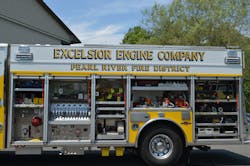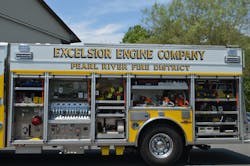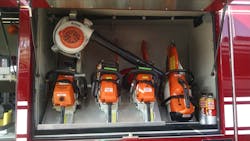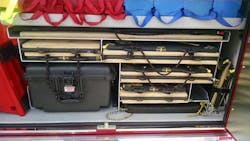The Apparatus Architect: It's the Little Things that Count
Many fire departments are relying upon multi-purpose units to provide service delivery in their response areas. The results have been that many pieces of fire apparatus, regardless of type, have become larger in size. Basic dimensions, such as overall length, overall height and the in-service weights of units, have become so large that the body configuration makes it difficult or unsafe from which to work.
While NFPA 1901: Standard for Automotive Fire Apparatus provides some guidelines, there is nothing in the standard that would prevent an apparatus committee to specify a vehicle that would be too large, high or heavy with respect to the operating conditions and demographics in the community.
At some point you may have observed a new piece of apparatus that was on display at a local fire show and thought to yourself “Why on earth did they do that?”. The level of customization on fire apparatus is in large part dependent upon the perceived needs of the department and the ability of manufacturers to develop new and innovative components that catch our attention. In past Apparatus Architect articles, we have often mentioned that early in the design process it is important to determine and analyze the mission of the vehicle. Engine, ladder, rescue and special service apparatus must be capable of safely operating in the response area along with carrying the personnel, tools and equipment to support fire/rescue incidents that you are likely to encounter.
While not to demean their capabilities on the fireground, combination apparatus, such as rescue engines and quints, have fostered the concept that departments can combine a number of components, tools and equipment into one vehicle that will bring the entire toolbox to the incident. In many cases, this is done in a vain attempt to fix a staffing issue. As a result, many all-hazards agencies have embraced the multi-purpose apparatus as the answer to their needs to carry most of their equipment on a single unit. But understand, you cannot be an all-hazards agency with only one fire truck.Weighty issues
Tool and equipment locations on single-axle apparatus may be dependent upon axle loadings where front, rear and side-to-side in-service weights should be determined during the pre-construction process. While Table 12.1.2 in NFPA 1901 provides some excellent guidance as to the minimum equipment payload weights that should be considered for the various types of apparatus, the responsibility for the actual equipment inventory and weight are the responsibility of the fire department and this information should be determined and provided to prospective bidders prior to contract.All apparatus manufacturers can provide a detailed weight analysis based upon the configuration of the apparatus, rated axle capacities along with the planned weight of portable equipment including tools, equipment, hose load and in-cab mounted components. For pumpers with enclosed compartment space of less than 250 cubic feet, the NFPA 1901 minimum allowance is 2,000 pounds and increases to 2,500 pounds for larger bodies. Unfortunately, there are many pieces of apparatus operating today that are overloaded as the equipment compliment was not specified and, over a period of time, additional tools are mounted on the apparatus which can result in poor braking, poor vehicle performance with increased maintenance costs, and significant out of service time.
During the specification development process, the apparatus committee, after determining the mission of the apparatus, should review the tool and equipment requirements starting with an inventory of existing apparatus. Most apparatus manufacturers have developed a number of standard body designs with specific compartment dimensions based upon the capacity of the water tank and hosebed to provide different lengths in order to meet fire department’s needs. The apparatus committee should inquire as to the various options to determine the best match for the overall length of the body and how this may impact the wheelbase and turning radius for the completed unit. Often, departments simply choose the largest size body available and then work backwards to make the tools and equipment fit within the allocated space. This frequently results in a mega-sized apparatus that carries everything but is not particularly good at anything on the fireground. This type of apparatus does not allow access to tight areas within the community and simply cannot maneuver in locations where older vehicles could easily fit.Dimension attention
When reading through manufacturer’s specifications, remember that all dimensions are not necessarily equal. Some specifications state the overall compartment dimensions in inches for the height, width and depth of each area. These numbers, while impressive, may not take into consideration the loss of height due to headers or the roll door shutter and the clear door opening past hinged doors or trim pieces. In addition, the depth of each compartment should be the clear useable space for equipment storage with the door closed. The use of slide-out trays for easier access to equipment must allow not only for the height of the slide mechanisms and thickness of the tray itself, but the side clearances required to pass through the door opening. Some of these dimensions are not normally provided in specifications provided by the apparatus manufacturers and will have to be determined after consultation with sales personnel and their engineering staff.
After the specific compartment dimensions are established you can begin to lay out your tools and equipment within each compartment area. If you had already developed the apparatus inventory of equipment, including dimensions and weights, there are several methods that you can use to lay out each compartment shelf, tray and tool board space. Several manufacturers and equipment-mounting companies can provide computer-aided designs (CAD) for each area within the compartment body. These CADs can be of great assistance to determine ahead of time, before any metal is sheared, that your equipment can be safely mounted in each location. Another technique that can be accomplished in the fire station is to mark out on the apparatus bay floor with tape each surface area, such as an adjustable shelf, tray or wall area, and locate the desired equipment within the space. Documentation of this work should include digital images and a listing of the appliances and equipment for each location. Also do not forget to allow space for the mounting hardware.
The upfront work conducted at this point in the design process can alleviate some of the issues that crop up later and can cost a great deal of time and money to solve once the apparatus goes into production. It is imperative that you find highly motivated apparatus committee members who are willing to do the work, understanding that the more work you do in the beginning will pay big dividends in the end as it relates to a reduction in change orders, time and costs. This work is particularly important if your department is working on the design for an apparatus that will be combining the equipment from several pieces of apparatus into a single unit. The apparatus manufacturer will be able to validate your requested tool and equipment locations while providing an accurate analysis of the anticipated in-service weight prior to construction. Failure to provide this level of detail during the design phase can lead to unbalanced side-to-side weight or overloaded apparatus, which in some cases cannot be easily modified to ensure a safe vehicle.Have a game plan
While tool and equipment mounting is one of the last items to accomplish prior to placing the unit into service, consideration must be given to how this work is going to be conducted. Departments that operate a fleet of units will typically have a standard equipment layout for each type of apparatus with one or more compartments used for individual response area requirements. After taking delivery of your new apparatus, all equipment that is going to be carried should be placed and mounted in secure non-marring brackets in all areas. This is critical with equipment carried inside of the cab including hand lights, meters, forcible entry tools and computer equipment.
When working on new apparatus specifications, the department should develop a complete equipment inventory, plan the space allocation that will be needed to safely accommodate and secure this equipment, and not fall into the common trap to acquire the largest body style available with the hope that everything will work out. Consider the life cycle of the apparatus, while leaving some open space for future equipment; the cost of tool and equipment mounting is nominal when compared to some of the more costly components that are installed on new units.




